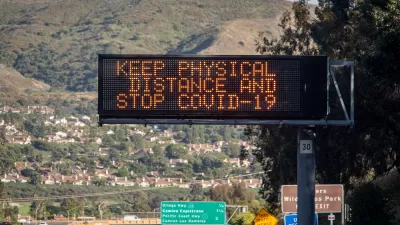Many think the two geographic divisions in CA are north and south, but this article uses economic data to show that the real division is between coastal and inland. These differences transcend economics and are revealed in public policies as well.
While the Inland Empire and the Central Valley were the fastest growing regions of the state in the last decade, that exurban growth has slowed to a halt.
Based in San Bernardino in what is known as the Inland Empire (along with Riverside County), Jennifer Medina provides insight into the vast economic differences between west and east. The region "posted an unemployment rate of 12.6 percent in March. Compared with Orange County, on the more prosperous, western side of California's vertical divide with an unemployment rate of 8 percent, it can feel like another world.... El Centro, on the state's southeast edge, has the highest unemployment rate for any metropolitan area in the country, nearly 27 percent."
Growth based on housing alone is unsustainable.
"While suburbs in the eastern parts of the state were some of the fastest-growing areas in the nation in the last decade, that growth has slowed to a near halt. Hans Johnson, a researcher with the Public Policy Institute of California, explains that "people were just following the building of roofs, so what you end up with in a bust, areas that were dependent on growth suffer tremendously when it dries up."
Stephen Levy, the director of the Center for Continuing Study of the California Economy adds that "places that existed just for housing are not going to come back anytime soon."
Transcending Economics
"The differences between the west and east are not limited to the economy; several studies have shown that the coastal areas are more politically liberal than their inland counterparts. New environmental laws, for example, may be embraced in cities focused on preserving the beach, but viewed as anathema to some inland political leaders who see regulations as a path to driving businesses out of the state."
FULL STORY: In California, Economic Gap of East vs. West

Planetizen Federal Action Tracker
A weekly monitor of how Trump’s orders and actions are impacting planners and planning in America.

Maui's Vacation Rental Debate Turns Ugly
Verbal attacks, misinformation campaigns and fistfights plague a high-stakes debate to convert thousands of vacation rentals into long-term housing.

San Francisco Suspends Traffic Calming Amidst Record Deaths
Citing “a challenging fiscal landscape,” the city will cease the program on the heels of 42 traffic deaths, including 24 pedestrians.

Amtrak Rolls Out New Orleans to Alabama “Mardi Gras” Train
The new service will operate morning and evening departures between Mobile and New Orleans.

The Subversive Car-Free Guide to Trump's Great American Road Trip
Car-free ways to access Chicagoland’s best tourist attractions.

San Antonio and Austin are Fusing Into one Massive Megaregion
The region spanning the two central Texas cities is growing fast, posing challenges for local infrastructure and water supplies.
Urban Design for Planners 1: Software Tools
This six-course series explores essential urban design concepts using open source software and equips planners with the tools they need to participate fully in the urban design process.
Planning for Universal Design
Learn the tools for implementing Universal Design in planning regulations.
Heyer Gruel & Associates PA
JM Goldson LLC
Custer County Colorado
City of Camden Redevelopment Agency
City of Astoria
Transportation Research & Education Center (TREC) at Portland State University
Jefferson Parish Government
Camden Redevelopment Agency
City of Claremont




























